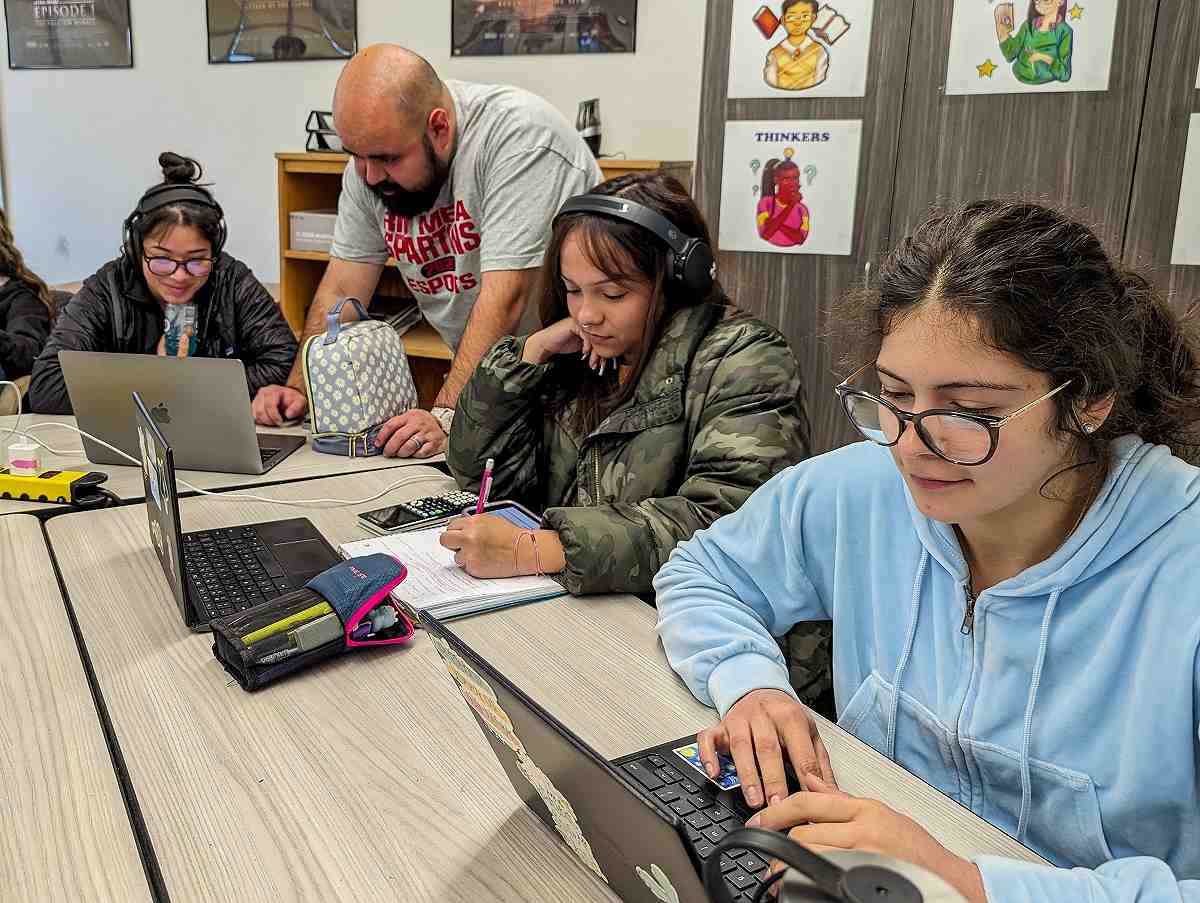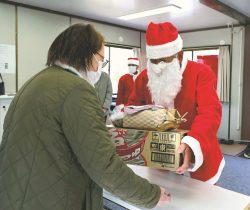
Ruben Jacquez helps his students in a data science class at Rio Mesa High School.
18:05 JST, March 6, 2024
OXNARD, Calif. – On a Wednesday morning in December, Dale Perizzolo’s math class at Adolfo Camarillo High School is anything but quiet. Students chat about the data analysis they’ve performed on their cellphone usage over a week, while Perizzolo walks around the room fielding their questions.
The students came up with the project themselves and designed a Google form to track their phone time, including which apps they used most. They also determined the research questions they’d ask of the data – such as whether social media use during class reduces comprehension and retention.
“It’s more real-world math,” said Nicolas Garcia, a senior in Perizzolo’s class. “We have the chance and freedom to choose what we’re doing our data sets on, and he teaches us how we’re going to work and complement it [in] our daily lives.”
Perizzolo is one of eight math teachers of an increasingly popular data science course offered at most schools in the Oxnard Union High School district, an economically diverse school system northwest of Los Angeles, where 80 percent of students identify as Hispanic. The district rolled out the class in fall 2020 in an attempt to offer an alternative math course to students who might struggle in traditional junior and senior math courses such as algebra II, pre-calculus and calculus.
California has been at the center of a heated debate over what math knowledge students really need to succeed in college and careers. With math scores falling nationwide, some educators have argued that the standard algebra-intensive math pathway needs a revamp, both to engage more students and to help them develop relevant skills in a world increasingly reliant on data. At least 17 states now offer data science – an interdisciplinary field that combines computer programming, math and statistics – as a high school math option, according to the group Data Science for Everyone. Two states, Oregon and Ohio, offer it as an alternative to algebra II.
But other math educators have decried a move away from algebra II, which they argue remains core to math instruction and necessary for students to succeed in STEM careers and beyond. In California, that disagreement erupted in October 2020, after the group that sets admission requirements for the state’s public university system (known as A-G) announced it would allow students to substitute data science for algebra II to help more students qualify for college. Math professors, advocates and even some high school educators argued that the state was watering down standards and setting students up for failure in college.
Then last July, the group reversed its earlier decision, and in February released new recommendations saying that data science courses (and to the surprise of some experts, even long-approved statistics classes) cannot be used as an alternative to algebra II. It remains unclear how the decision will reshape college admissions; additional guidance is expected in May.
In Oxnard, educators say they have been left in the dark about how these decisions affect course offerings for their students. They argue that, more than ever, students need real-world math to help them succeed in the subject. They say the expansion of data science – some 500 Oxnard district students have taken it to date – has reoriented teachers’ and students’ approach to math.
“Data science is changing their view of math,” said Jay Sorensen, Oxnard’s educational technology coordinator, who helped design the class. “It changed their perspective or their view of what math is, because they maybe didn’t enjoy math or were frustrated with math or hated math before.”
Many students in Oxnard stop taking any math after junior year of high school and the district has been trying to fix this for almost a decade. In 2015, Tom McCoy, then the assistant superintendent of education services, jokingly asked Sonny Sajor, the district’s math instructional specialist, “Can I get some math for poets?”
That started a conversation on what math classes might benefit high-schoolers who struggled in the subject and who didn’t plan to pursue science or math fields or attend a four-year college, said McCoy, who became Oxnard’s superintendent in 2020.
Inspired by a UCLA seminar they attended on data science for high-schoolers, Sajor and Sorensen designed the new course and partnered on it with the educational technology vendor Bootstrap World. Oxnard’s first data science classes generated enough student interest that the district expanded the course to more schools, and its popularity has continued to grow.
But not all educators in Oxnard were on board. Some math teachers, for example, questioned whether the data science course – which had been approved as an advanced statistics course equivalent to general statistics courses – was really equivalent to an advanced math course.
Oxnard Union’s data science teachers, though, say they’ve seen benefits.
“It’s giving kids exposure to really practical math, and it’s also creative,” said Allison Ottie Halstead, who teaches data science along with honors pre-calculus and A.P. statistics at Rancho Campana High School.
Most of Oxnard’s data science classes enroll a mix of students who are using the course to fulfill their required third year of math and those who have already taken algebra II. According to district data, students who took data science as juniors in the 2022-23 year were more likely to sign up for a math class their senior year. Only about 10 percent of those students enrolled in math III, an integrated math class that’s equivalent to algebra II; larger shares enrolled in statistics, math for finance literacy and other classes.
Nizcialey Dimapilis, a senior at Channel Islands High School, said she is taking data science and A.P. calculus simultaneously to prepare for computer engineering courses in college. “I thought this class would be more useful because it involves coding, which is completely kind of new to me,” Dimapilis said.
Some students said it helped them grasp math concepts they’d been introduced to in past classes. Jaya Richardson, a senior taking data science at Oxnard High, said she doesn’t consider herself “a math person.” As a junior, she took math III and didn’t get the grade she wanted.
Instead of having her repeat the class for a higher grade, her counselor suggested she take data science. She said she’s happy with the decision and plans to pursue a degree in biology at a University of California or California State University System campus.
“It’s still stressful. It’s still hard, but it’s more beneficial,” she said of the data science class. We still do math in here, but it breaks it down in a way where I’m able to understand it.”
But many STEM professors are worried about the consequences of experiments like Oxnard’s.
Jelani Nelson, professor of electrical engineering and computer sciences at the University of California at Berkeley, argues that most data science courses offered in high schools are low level and don’t comply with UC and CSU college admission criteria that alternatives to algebra II build on students’ earlier math coursework.
Without an understanding of what he calls “foundational math” – algebra I, geometry and algebra II – he says, students won’t succeed in college courses in computer science, math, technology and economics. Even art can draw on foundational math, he noted. Perspective drawing, for example, uses geometry.
Adrian Mims, founder of the Calculus Project, a nonprofit that works to increase the number of Black, Hispanic, Indigenous and low-income students in advanced mathematics, said swapping out data science for algebra II has unintended consequences.
Standardized tests including the SAT and college math placement exams cover algebra II, he said. He said he worries that students who opt for data science instead will be stuck in remedial math courses “not because they can’t learn the math, but because they made decisions in high school that deprive them of the opportunity to learn the content for them to do well.”
Rather than replacing algebra II, data science concepts could be infused into algebra II courses, and data science courses that include some algebra II and geometry could be offered as electives to students who’ve already completed algebra II, Nelson and others said.
Others, though, don’t share those concerns. Pamela Burdman, founder of Just Equations, a nonprofit rethinking the role of traditional math pathways in high school, points to data showing that many students who take algebra II in high school learn little. She said emerging research suggests that courses like data science could have “more potential for bringing students into STEM” than the traditional preparatory math courses.
Despite the recent focus on the UC admissions requirements, only about 400 applicants out of roughly 206,000 in the last admissions cycle listed that they’d taken data science or statistics in lieu of algebra II, she noted.
“I do worry that the debate over data science versus algebra II is sort of a distraction,” she said.
Teachers and school guidance counselors in Oxnard are wary of wading into the math debate with their higher ed peers. But they aren’t afraid to voice their discontent with what they view as a disconnect between students’ needs and higher education.
Daniel Cook, a learning, instruction and technology coach at Camarillo High, said that students come into high school behind in math and that the pandemic only made the problem worse. Yet colleges still expect students to have mastered algebra II concepts and shut the door on those who haven’t.
Cook said that at Camarillo High, some 44 percent of sophomores are not on track to be A-G eligible because of math, so they’re getting a message early on that they’re not college material. By senior year, the figure is about 25 percent.
Traditional math curriculum “is essentially focused on preparing students for STEM pathways in college,” Cook said. The July vote and subsequent policy recommendations to nix data science as an option for college applicants, he said, is a “slap in the face to students who have interests that are not STEM-related.”
Educators in Oxnard are trying to cope with the uncertainty created by the state’s higher education system. With data science no longer counting toward college admission, Oxnard will eventually limit the course to students who’ve already taken, or are taking, algebra II, according to Sajor. The district is also considering a pilot course that would integrate algebra II and data science.
Such a course might ultimately be better for the district, Sajor said, because it would help more students engage with algebra II concepts while also introducing them to coding and data science.
Still, data science students like Emma-Dai Valenzuela say the class in its current form has been invaluable. A senior at Pacifica High School, Valenzuela said the course has allowed her to fulfill her graduation requirements while actually succeeding in a math class.
She transferred into the class after struggling in math III, the integrated algebra II course, she said. Valenzuela plans to join the Navy before attending college and said her recruiters told her this course would offer a basic understanding of coding and math she can build on later.
“This is more hands-on,” she said. “We’re constantly doing new things.”
"News Services" POPULAR ARTICLE
-

American Playwright Jeremy O. Harris Arrested in Japan on Alleged Drug Smuggling
-

Japan’s Nikkei Stock Average as JGB Yields, Yen Rise on Rate-Hike Bets
-

Japan’s Nikkei Stock Average Licks Wounds after Selloff Sparked by BOJ Hike Bets (UPDATE 1)
-

Japanese Bond Yields Zoom, Stocks Slide as Rate Hike Looms
-

Japan’s Nikkei Stock Average Buoyed by Stable Yen; SoftBank’s Slide Caps Gains (UPDATE 1)
JN ACCESS RANKING
-

Keidanren Chairman Yoshinobu Tsutsui Visits Kashiwazaki-Kariwa Nuclear Power Plant; Inspects New Emergency Safety System
-

Imports of Rare Earths from China Facing Delays, May Be Caused by Deterioration of Japan-China Relations
-

University of Tokyo Professor Discusses Japanese Economic Security in Interview Ahead of Forum
-

Japan Pulls out of Vietnam Nuclear Project, Complicating Hanoi’s Power Plans
-

Govt Aims to Expand NISA Program Lineup, Abolish Age Restriction
























